A blog with 3 chapters
Table of contents
Chapter one-This and That,
Chapter two-Small Format tapestry
Chapter three- Getting from A to B
But,first an announcement of an up coming class! I will be teaching I am going to do more teaching in my studio and having others teach master workshops in my studio. So I am letting everyone know that I will be teaching Tapestry, Soumack and Friends in my studio on August 29—31, 2015 and for anyone who wishes to extend the class for 5 days for further study of Soumack and friends. Cost is 275 for 3 days or 400.00 for the full 5 days. Please contact me at kathetoddhooker@comcast.net if you are interested.
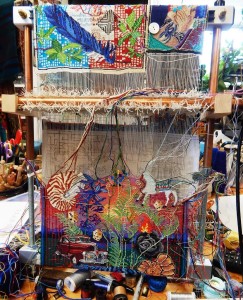 |
| front of loom |
Chapter one—The end of a fairly long project is in sight! I
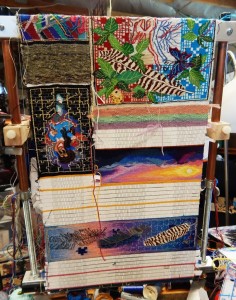 |
| back of loom |
wanted to see how close I could weave to the top heddles and how much of a circular warp I could use on my Mirrix loom. I
will be cutting off 6 new pieces by the end of the week or not. Seems like I won’t quite finish before I leave the first of June.
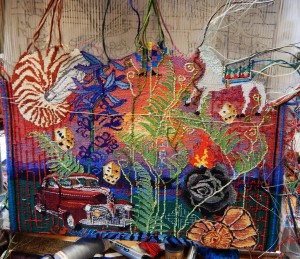
BUT, they will be by July 1 ending a 2.5 year period of work.
I am having an exhibit of 8 of my new pieces that have never been shown at the ETC or the Eugene Textile center in Eugene, Oregon. Minus one piece-Metamorphic transmutation 7x7x7+infinity.
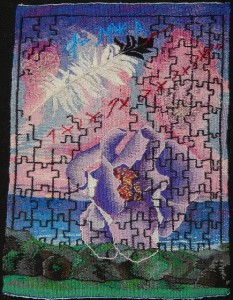 |
| Metamorphic transmutation 7x7x7+infinity |
But, Before that I will be in the South and South west I am traveling down to visit with friends in Arizona, New Mexico and other places. Finally ending up in Natchitoches, Louisiana for the opening of the 8th ATA Small Format Exhibit-Honoring Tradition , Inspiring innovation for which I won the Tietalbaum award.
Minus one piece-Metamorphic transmutation 7x7x7+infinity that will be at the 4
The first venue of the exhibit will be at is Orville Hanchey Gallery, NSU, Natchitoches, LA. Starting June 8th. The opening is June 11th. My husband and I have decided to attend so I’ll be driving cross country-Almost 3,000 miles and visiting friends and galleries along the way.
Thus ending a 1 year hiatus of exhibiting my work.
The reasons I choose -several– I needed a break from deadlines and break away from the exhibiting mentality. My break started from a question that Yael Lurie asked me. Why was I still entering shows? I couldn’t thing of a reason other then because they are there. Definitely not a good reason
 with the time and expense of entering shows. It was never about they jurying aspect or whether I got in. I inherited a gambling gene and entering shows feeds that.
with the time and expense of entering shows. It was never about they jurying aspect or whether I got in. I inherited a gambling gene and entering shows feeds that.I did enter the ATA show, but only because small format tapestry is close to my heart and I’ll always support it by entering good well thought out exhibits with catalogues.
In the process I realized what I really want to do is tell stories in my own ways… SO I am… Which leaves me with 8 pieces to finish before the first of July. They will all have the same birthdate. Teaching and writing will always be a given in the process of telling stories with my weaving.
 Another clarifying event or reason – I help put together 2 Tapestry Topic issues On small Format Tapestry- One has been published and the other will come out this fall. Not that it took so much of my time, but it started me to really thinking about issues and what I want to do. I realized that I was being consumed by the need to enter and not so much by the weaving and designing. I realized I was feeling burnt out. So I took a break. Made a bunch of life changes. Did a lot of journaling-lost over 100 lbs.(no, I am not sick.) and now I am only doing those things that I want to do, when I want to do them, for why I want to do them, knowing when to let things go, letting go and new goals-see chapter 3, if your interested.
Another clarifying event or reason – I help put together 2 Tapestry Topic issues On small Format Tapestry- One has been published and the other will come out this fall. Not that it took so much of my time, but it started me to really thinking about issues and what I want to do. I realized that I was being consumed by the need to enter and not so much by the weaving and designing. I realized I was feeling burnt out. So I took a break. Made a bunch of life changes. Did a lot of journaling-lost over 100 lbs.(no, I am not sick.) and now I am only doing those things that I want to do, when I want to do them, for why I want to do them, knowing when to let things go, letting go and new goals-see chapter 3, if your interested.
Chapter 2-What is small format/ small scale tapestry?
The term format deals with size and shape– plain and simple. Sometime in the near past a French tapestry designer by the name of Lurçat(of course we shouldn’t forget about Wm. Morris’s and the British weavers in all of this.) decided rather arbitrarily that tapestry wasn’t tapestry and could not be defined as tapestry UNLESS it was larger than a square meter, at least 10 epi, wool, architectonic and muralistic and Eurocentric. Making void thousands of years tapestry history and tradition in the name of fine art and revitalizing the tapestry industry-perhaps-or not-and very related to William Morris earlier try and perhaps the Bauhaus…etc., etc. etc. and of course US weavers followed suite for all of the usual reasons…
In the US until not too long ago- the 90’s.-his definition and opinion of tapestry defined who and what tapestry was in the US.
When I first began to weave small format tapestry small format weavers weren’t allowed to exhibit in tapestry shows/exhibits because of the way tapestry was being defined. One
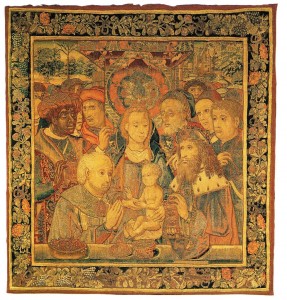 |
| not tapestry less then a square meter? |
example of many, In 1991 at the Fine Line Conference it was also decided by some very prominent tapestry weavers- Marc Adams included- and teachers, etc. that tapestry had to be no less then 10epi, wool, over 36 by 36 inches in size, only four sides and that things that were shaped such as Dragon robes couldn’t be tapestry.(for more info-check out the last issue and the issue to come on small format tapestry.) “They”, also, decided Navajo and SW weavers were also not doing tapestry because the items that were produced were utilitarian rather then “fine tapestry art”. “They”, also ruled out Middle Eastern weaving, Coptic and most traditional
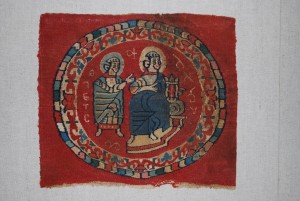 |
| Coptic smaller then a square meter-not a tapestry? |
Scandinavian tapestry as not tapestry, because they were utilitarian and or too small. These ideas began to change in the mid 90’s and with the rise of good small format looms, the internet, exhibits for small format and the erasure of size requirements attitudes are changing and Small format weaving is becoming a growth industry and much more acceptable in the tapestry world. Organizations such as ATA and others have removed size restrictions from exhibits and held to the definition that tapestry is a weft faced unbalanced plain weave with the possibility of a discontinuous warp.
 |
| Not tapestry-woven in silk not |
Since then, and amid great controversy, Small format tapestry has come to be defined in two ways-well actually 3 ways-15 by 15 inches, under 10 inches by 10 inches/100 square inches. There is also a sub category where the pieces can be no larger than 5 by 5 inches.
My personal druthers is that there should not be size limitations on any tapestry exhibit. Even though I am grateful that there are exhibits that have size limitations just so we can exhibit which are helping do away with the built in systemic prejudices against small format tapestry.
There is a but- Mary Diederich a well know small format/small scale tapestry weaver in the 90’s once said that by doing this we need to be careful that we don’t create a barrio or ghetto that would then limit where small format tapestry could be shown at the exclusion of large format tapestry- Again creating a rift between the acceptable and not acceptable tapestries .
Small format weavers were often told in the very near past they were weaving samplers or in one case dish clothes-and in a polite way mixed media or fiber art.
(Slight aside– I often wondered if instead of being a size issue if it wasn’t really originally a
 |
| Marc Adams |
gender issue. I was often told that small format tapestry and it’s designers were to feminine-granted many of my designs included flowers- also perhaps to feminine and one had too look past that feminine quality to find meaning. On the other hand there’s whole traditions of males painting flowers in Europe. And, of course Marc Adams designed many florals, So, maybe the issue is still just size with just a hint of gender issues.)
Okay that said.
The other thing that really needs to be said is that there is a difference between scale and format.
Format only defines the physical nature of the tapestry. Example the edges of the tapestry are or maybe 5 inches x 5inches or 5 foot x 5 foot. Format defines the size and shape of a given piece.
Scale/scale is determined by warp size and weft size, number of picks or passes in an inch. Example– I weave at 20-22 epi. Epi or sett is determined by the size of the warp and how far apart or how close the warps are together on the loom. Mostly 38-40 passes per inch(a pass is an over and a back) Picks or passes are determine by how large the weft bundle is. So one of my tapestries “And he…” is 28 inches by 20 inches at 22 epi. Should be considered to be large format, but small scale.
A piece woven at 22 epi but 15 inches by 15 inches or less would be small format even if woven at 8 wpi and maybe 10-12 passes per inch, but would be large scale and small format.

Same cartoon woven in two different formats and scale. Difference one is twice the size or half the size of the other. Only real change is one is upside down with a shell removed and a nautilus added.
Okay that said-why is it important to know this?
‘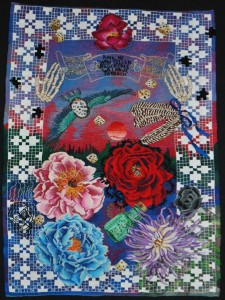 |
| “And He who tells a bigger tale will have to tell a lie” |
The biggest complaint I hear all of the time about small format tapestry is one can’t get enough detail in small format work, which is probably true, if you are trying to weave a small format design at a large warp sett or scale.
 |
| Detail “And He…” 22 epi. |
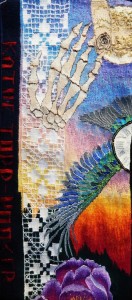 |
| “And He…” 10 epi |
My biggest complaint is that often I weave small scale at too large of a format-more detail and way more time then I need to expend on a given piece. Good example was my piece –(not that I don’t love the piece) “and he…” at 165 days of weaving time. Instead of 40 to 60 hours of weaving on an average sized small format/small scale piece-8 times bigger then my average piece. It was a large format designed to be 4 feet by 6 feet that I shrunk by about half so that I could weave it in a small format/small scale size. Consequently, it did help me make a life decision. I sold both looms-my 6.5 Shannock and my Mirrix Zeus so that I would never be tempted to do that again! Life lesson learned- I am a small format/small scale weaver, always!
 |
| Small format project-a place to grow ferns for weaving |
So, I have a couple of things that should be considered when designing a tapestry or if you would a “modest proposal”(J. Swift) for designing and weaving tapestry-if you would.
1. Free your creativity-approach each design with an open mind. Just because you were taught to weave at a certain size, specific materials, or tradition, or warp sett, weft bundle size doesn’t mean you have to weave tapestry with the materials you were taught to use.
2. Design your tapestry- first-THEN DECIDE on the size you wish the final tapestry to be and how
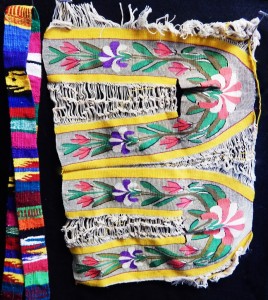 |
| Coptic woven slippers and a belt! |
you want to use the finished tapestry or the function of the finished tapestry. It is easy to take a design to a lazerquck or UPS or copy shop or use your computer programs to create a size you want a design to be and have it blown up to the size you wish it to be.
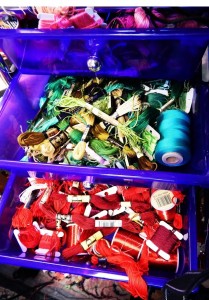 |
| Choices–Wool, embroidery floss, silk rayon, cotton seine twine, Dual duty craft thread |
3. Decide-The hand of the fabric-how drape-able, stiff, fabric-like,
thickness-etc.
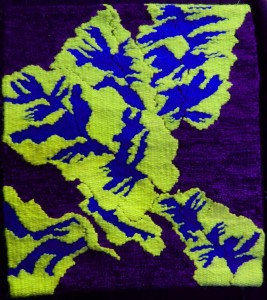 |
| Caladium Lakes that was eventually woven at five feet 38 inches, but here is a 12 inches by 16 |
4. Look at the design and decide how much detail you want in a square inch. Detail is a question of how many passes and how many warps in a given inch. Consider how much detail is in the design. Then decide on warp sett, warp and weft materials and format taking
into consideration what you want the end product to be. Not every design should be woven or size determined by warp sett.
 |
| fewer wefts-white shape is halfed in size and the amount of weft in each shape. |
5. Learn to scale your materials to what you want in the design. IF you want more detail in the weft passes in a given space. Use fewer strands in your weft bundle. This allows you to do more passes in a given space. On the other hand if you plan ahead you can double up the warps and work the warps in groups for larger scale within a given area. (use
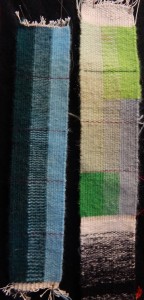 |
| On left 5 strands of Avl to begin each section is one less thread in the weft bundle. On right paternayan 4 strands with descending number of threads in weft bundle. |
soumack on the fell line so you don’t end up with lice where the
shed goes greater or smaller) You can eve use a supplemental warp that floats on the back until you want to increase the warp sett for more detail and them float it on the back again when not needed.
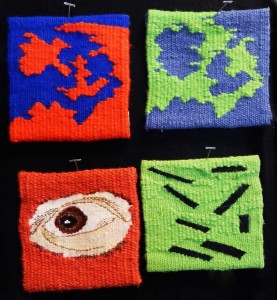 |
| sampling using 5 and 10 epi-doubled warps. The eye uses both doubled warps at 10 epi and lines are done and hatches with only one thread in weft bundle. |
5. This is also the time to think about what could limit the size you want to weave-One’s body, ones loom(s), eyesight and Time limitations. If you try to weave a small scale/ large format piece it could take a very long time as I discovered in one large format small scale piece.
6. Now make a decision based on your answers! Have fun with it! For me it takes just as much time to weave the same piece at any format. 10 epi or 22 epi is the same technique, same skills. The format is just different. 10 epi will be twice the size as one woven at 20-22 epi. Scale is the determining factor at a given format as too how long it takes.
Chapter 3 Getting from A to B
I am tired of the grind of trying to keep up with internet things. I am finally realizing how much that time/energy involved does away with what I truly want to do-Tapestry, writing about tapestry and even teaching tapestry. To be happy I need to weave 4- 6 hours a day for 6 hours a week, but will settle for 5. (just trying not to be excessive-LOL!) .
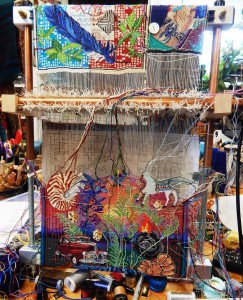 |
| How much time I can afford away from the loom and still be happy! |
I am so tired of trying to learn new things. Things that change faster than I can keep up. At what point does one say stop and get off and stay put. New computer programs drive me up the wall let alone creating new webpages, business forms, and etc. Seems to zap my energy. But, I am still maintaining my 4-6 hours of weaving a day.
SO I have been re-evaluating how I spend my time and energy. I am really excited about the blogs I am planning on doing . I have a 40 page lexicon of tapestry terms that I have compiled over the last almost 40 years which will be the first document in the Tapestry compendium blog.
But-This blog is about wants and moving on. I am going to do more teaching in my studio and having others teach master workshops in my studio. So I am letting everyone know that I will be teaching Soumack and Friends in my studio on August 29—31, 2015 and for anyone who wishes to extend the class for 5 days for further study of Soumack and friends. Cost is 275 for 3 days or 400.00 for the full 5 days.
 |
| Pitcher blants about to bloom! |
I am redoing my blog(s)There will now be two perhaps 3. One being the creation of something called a Tapestry Compendium(and more). This blog will morph into one that will still be about teaching answering questions and making tapestry information and lists available to everyone. Hopefully, but not promised it will or portions of it will morph into a tapestry zine about technical stuff, bibliographies list of blogs, suppliers book reports or reviews of tapestry books. . I want to create a more interactive blog where people can ask questions about tapestry and get answers to problems– A place where technical articles-old and new- can be placed and available and easily obtained by all.
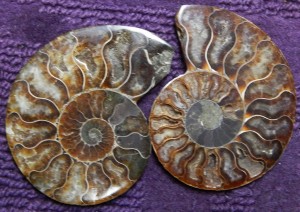 |
| Earth stars or fossilized nautilus. Relic from my Gramma’s beliefs. |
There will also be pages of tapestry tools and their uses and looms as I and others gather info-eventually-I am hoping for this to contain tapestry loom manuals. I have had some generous contributors over the years. Many of the terms have come from places long forgotten. Another page will be a list of blogs that I have gathered through Tapestry 2005 which actually began in 1996. This will be an extension of a blog list attached to the list that yahoo will not allow me to update-SO, I’ll find a way to make an updatable blog list available to all connected to My Tapestry2005 yahoo group list. My hope is that others will contribute and it will become more and more over time.
This blog here at this address- This blog will be about what I am doing in tapestry. The third blog when the new webpages are finished will be attached to my former business that will be morphing in to a business called Between & Etc. Fine Fiber Press will still be part of this new business. It is just taking time to put all together mainly-because I have been stymied and passively refusing to learn new programs. True luddite that I am-instead of learning new programs-I am going to use what I know how to do and just start.
And if you’ve read this far- Here’s kinda cool trick that I use. I started doing this when some my older students kept pulling the knotted threads used to sew cartoons and stabilize slits would pull through
and snag the weft on the way out. The thread is doubled through the holes of the button.
Enuff of this for now!

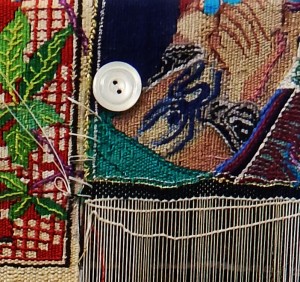
Would love to admire your thread stash!! 🙂
Would love to have you admire it. We now have Paternaya, Alv Norwegian yarns and Needle point yarns that can be bought in packages 24 inches long.AND, of course embroidery floss for 30 cents a skein!
kathe
Fantastic, thought-provoking discussion! Thank you.